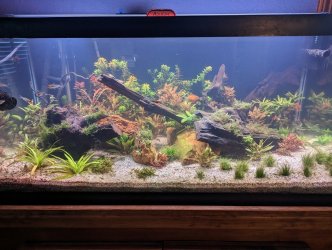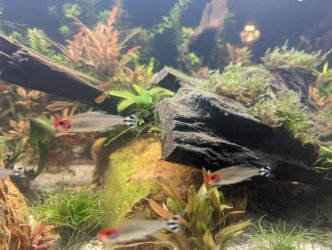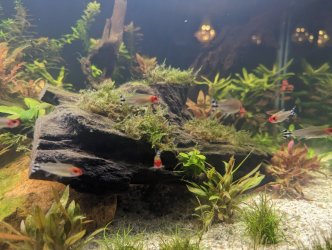BigAznDaddy
New Member
- Joined
- Jan 13, 2009
- Messages
- 5
- Reaction score
- 0
Hi,
I think I know the issue but wanted to check here. I think my issue is high PH impacting the fish. I didn't pay attention to the substrate previously and I think it might be one that increases the PH. Things seemed to be going fine and I added all the background stem plants a few months back. About 1 month back i noticed red gills on my fish. I tried increasing the water change amount and medications but it didn't seem to really help things. I have read that overnight the plants can increase the PH of the tank. I've noticed that the fish do seem to get worse overnight but I'm not 100%. For now I'm going to try to reduce PH chemically and grab some peat moss. I think ultimately i need to replace the substrate but any other thoughts would help. Thanks
Tank size: 50 gal
tank age: 11 months
pH: 8
ammonia: 0
nitrite:0
nitrate: 5ppm
kH: ~ 120
gH: ~200
tank temp: 76
Fish Symptoms (include full description including lesion, color, location, fish behavior): Red gills, gasping, corys often surface breathing
Volume and Frequency of water changes: past 2 months 20% each week
Chemical Additives or Media in your tank: I think substrate is the issue. might be crushed coral or limestone
Tank inhabitants: 8 rummy nose, 10 glolight danios, 1honey red gourami, 8 corys, 3 amano
Recent additions to your tank (living or decoration): added lots of stem plants 2 months ago and glowlights about 1 month back replacing some black phantom tetras that were previously in the tank
Exposure to chemicals:
Digital photo (include if possible): setup and substrate. only had anubias previously so most plants are from last few months
I think I know the issue but wanted to check here. I think my issue is high PH impacting the fish. I didn't pay attention to the substrate previously and I think it might be one that increases the PH. Things seemed to be going fine and I added all the background stem plants a few months back. About 1 month back i noticed red gills on my fish. I tried increasing the water change amount and medications but it didn't seem to really help things. I have read that overnight the plants can increase the PH of the tank. I've noticed that the fish do seem to get worse overnight but I'm not 100%. For now I'm going to try to reduce PH chemically and grab some peat moss. I think ultimately i need to replace the substrate but any other thoughts would help. Thanks
Tank size: 50 gal
tank age: 11 months
pH: 8
ammonia: 0
nitrite:0
nitrate: 5ppm
kH: ~ 120
gH: ~200
tank temp: 76
Fish Symptoms (include full description including lesion, color, location, fish behavior): Red gills, gasping, corys often surface breathing
Volume and Frequency of water changes: past 2 months 20% each week
Chemical Additives or Media in your tank: I think substrate is the issue. might be crushed coral or limestone
Tank inhabitants: 8 rummy nose, 10 glolight danios, 1honey red gourami, 8 corys, 3 amano
Recent additions to your tank (living or decoration): added lots of stem plants 2 months ago and glowlights about 1 month back replacing some black phantom tetras that were previously in the tank
Exposure to chemicals:
Digital photo (include if possible): setup and substrate. only had anubias previously so most plants are from last few months






